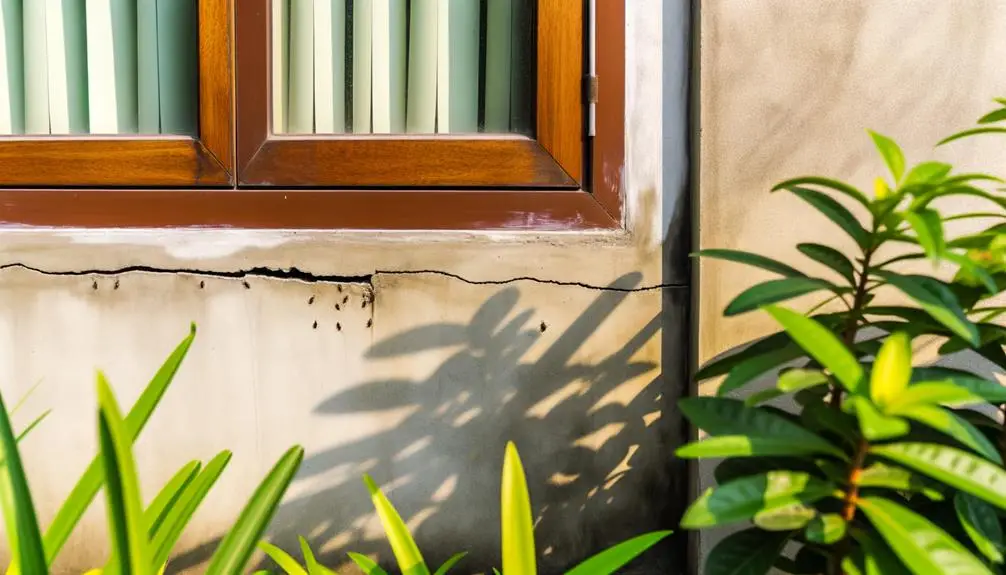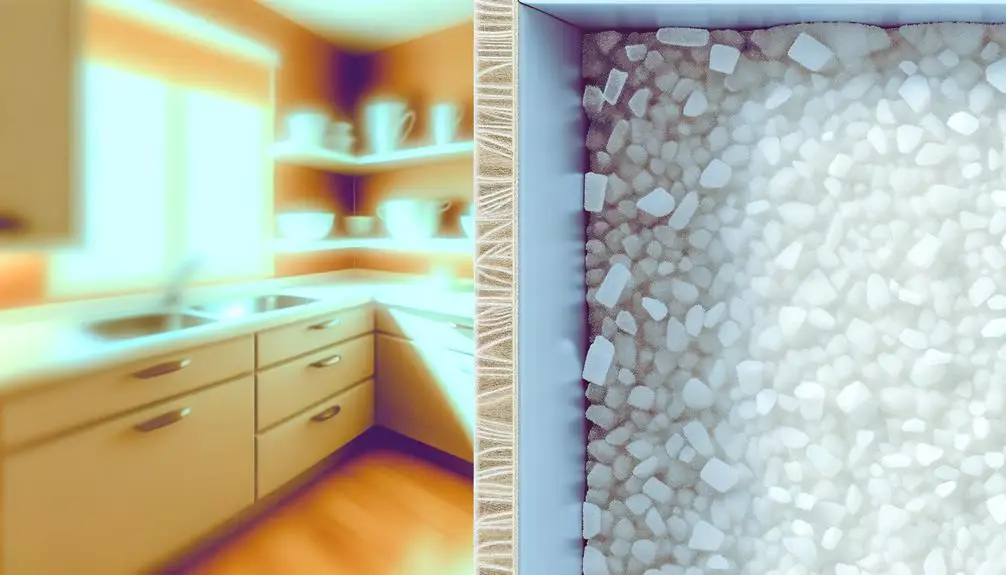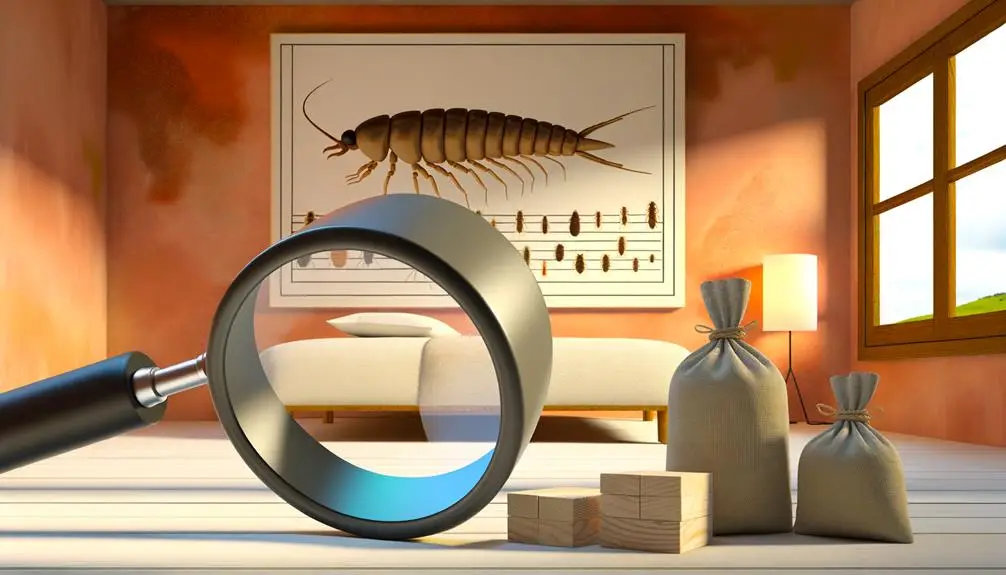To control silverfish naturally in your home, start by reducing indoor humidity. Utilize dehumidifiers and hygrometers to maintain ideal levels between 30-50%. Seal food containers and clothing storage to restrict access to starch and natural fibers, which silverfish consume. Employ natural repellents like diatomaceous earth and use essential oils such as lavender or peppermint. Regularly declutter spaces to eliminate hiding spots, and use natural predators like spiders or centipedes to manage populations. Conduct periodic maintenance, guaranteeing seamless seals around entry points. These practical strategies effectively guarantee a silverfish-free environment, and there’s much more to discover about managing pests.
Key Takeaways
- Reduce indoor humidity to below 50% using dehumidifiers and improved ventilation to deter silverfish.
- Store food in air-tight containers and protect clothing with vacuum-sealed bags to prevent silverfish access.
- Use natural repellents like diatomaceous earth, bay leaves, and essential oils to repel silverfish.
- Regularly inspect and seal entry points with silicone caulk to prevent silverfish from entering.
- Conduct regular vacuuming and decluttering to disrupt silverfish habitats and eliminate food sources.
Reduce Indoor Humidity

When tackling silverfish infestations, reducing indoor humidity is essential since these pests thrive in moist environments. Silverfish are particularly drawn to areas like basements, attics, and bathrooms where humidity levels often soar. By employing humidity control, you can effectively deter these unwanted guests. Start by integrating naturepest holistic pest control methods, which focus on environmentally-friendly and sustainable practices. Utilizing effective pest control measures helps create an inhospitable environment for silverfish. One practical solution is to enhance ventilation in your home. Utilize bathroom fans during and after showers to expel moisture-laden air. This simple step is a cornerstone of natural pest control, creating an inhospitable environment for silverfish. Additionally, inspect your home for any water leaks or plumbing issues that might be contributing to elevated humidity levels. Fixing these problems not only aids in silverfish prevention but also conserves water and maintains structural integrity.
Integrated pest management (IPM) provides a holistic approach by combining multiple strategies to manage pests. Within this framework, humidity control becomes a pivotal tactic. You can keep your living spaces dry by strategically placing absorbent materials, such as silica gel packets, in key locations. These packets draw moisture from the air, ultimately reducing relative humidity.
For a more structured humidity control regime, consider using hygrometers. These devices measure indoor humidity levels, allowing you to make informed decisions about when and where to implement moisture-reducing measures. By prioritizing holistic solutions like these, you align yourself with a community of individuals who value sustainable living while effectively controlling silverfish in a natural manner.
Use Dehumidifiers
To effectively manage silverfish infestations, deploying dehumidifiers is a strategic measure that can substantially reduce indoor humidity levels. Silverfish thrive in environments with high moisture, a common issue in areas like South Florida, Miami Dade County, and Broward County, where humidity is prevalent. By integrating dehumidifiers into your home environment, you can create conditions less conducive to silverfish survival, aligning with Integrated Pest Management (IPM) principles that promote environmentally sensitive approaches. Additionally, understanding the impact of moisture on various pests, including common pests in Florida, can help you take preventive measures against infestations.
Begin by evaluating the humidity levels in your home using a hygrometer. Ideal indoor humidity should be maintained between 30-50% to deter silverfish. Place dehumidifiers strategically in high-risk areas such as basements, attics, and bathrooms, where moisture tends to accumulate. These devices work by drawing in humid air, cooling it to remove excess moisture, and then releasing drier air back into the room, effectively lowering humidity levels.
In South Florida’s climate, dehumidifiers are not just a luxury but a necessity for pest control. Regularly empty the water collection container or verify the dehumidifier has a continuous drainage option to maintain efficiency. Additionally, combine dehumidification with other IPM strategies, such as repairing leaks and improving ventilation, for thorough pest management.
Seal Food Containers

Why should you seal food containers when battling a silverfish infestation? Silverfish are nocturnal insects attracted to environments rich in starches and sugars, which you might unknowingly provide through unsealed food storage. By sealing your food containers, you create an unbreachable barrier that denies these pests access to their food sources, effectively reducing their population and discouraging further infestation.
In the domain of entomology, it’s vital to understand that silverfish possess a unique digestive system capable of breaking down complex carbohydrates found in common household items like cereals, flour, and even glue. Utilizing air-tight containers not only protects your food from contamination but also disrupts the silverfish’s food chain, as they rely heavily on these nutrients for survival and reproduction.
Selecting the right storage solutions is critical. Opt for containers made from durable materials like glass or high-density polyethylene, which prevent silverfish from sensing the food’s aroma. Confirm a proper seal by checking for mechanisms like locking lids or silicone gaskets. Such features are important in maintaining an airtight environment, further deterring these pests.
Embrace this strategy as part of a thorough integrated pest management (IPM) approach. Sealing food containers aligns with the community-driven effort to maintain a pest-free home, where shared knowledge and collective action yield the best results. By adopting these scientifically-backed methods, you’re not just safeguarding your provisions but also contributing to a supportive network of individuals dedicated to maintaining a healthy living space.
Store Clothes Securely
Just as sealing food containers helps to protect your provisions from silverfish, securely storing clothes is equally important in curbing these pests. Silverfish are drawn to natural fibers such as cotton, linen, and silk due to their cellulose content. To prevent them from feasting on your wardrobe, you should store clothes in air-tight containers. Utilizing vacuum-sealed bags or plastic bins with tight lids will act as a barrier, keeping these unwanted guests at bay.
Here’s a quick guide to storing clothes securely:
| Item | Recommended Storage Solution |
|---|---|
| Wool Sweaters | Vacuum-Sealed Bags |
| Cotton Shirts | Plastic Bins with Lids |
| Silk Scarves | Cedar-Lined Chests |
| Linen Dresses | Garment Bags with Zippers |
Silverfish can infiltrate through the smallest openings, so ensuring that your storage solutions are airtight is critical. Vacuum-sealed bags not only save space but also provide an impenetrable fortress against pests. Plastic bins should be checked for any gaps or cracks that might allow entry. Cedar-lined chests and garment bags with zippers offer additional protection, as cedar naturally repels insects.
Moreover, consider incorporating silica gel packets in your storage areas. Silica gel helps maintain low humidity levels, an environment in which silverfish struggle to survive. By following these strategies, you create a united front against silverfish infestations, protecting your clothes and contributing to a pest-free household. Remember, it’s not just about storage; it’s about creating a sanctuary for your belongings, one that aligns with your community’s shared goal of a harmonious, silverfish-free home.
Minimize Clutter

Reducing clutter is essential for effective silverfish control, as these pests often hide and thrive in disorganized spaces. Silverfish are nocturnal insects that seek out dark, undisturbed areas filled with paper, fabric, and other organic materials. By minimizing clutter, you can greatly reduce their hiding spots and disrupt their life cycle. Start by systematically evaluating each room in your home. Identify items that no longer serve a purpose or haven’t been used in the last year. Donate, dispose, or repurpose these objects to create a more organized environment.
Focus on areas that are common silverfish habitats, such as basements, attics, and closets. In these spaces, avoid stacking boxes directly on the floor. Instead, use shelving units to keep items elevated, reducing the likelihood of moisture accumulation, which can attract silverfish. Opt for plastic storage bins instead of cardboard boxes, as the latter can serve as both a food source and nesting material for these pests.
Regularly vacuum and clean these areas to remove dust and potential food debris. Pay close attention to corners, edges, and crevices where silverfish might hide. Integrating a bi-weekly cleaning routine can help maintain a clutter-free space, making it less hospitable to silverfish. Additionally, consider using silica gel packets in storage areas to absorb excess moisture, creating a less favorable environment for these insects.
Recycle Paper Products
Recycling paper products is a crucial step in managing silverfish infestations because these insects are drawn to the cellulose found in paper. As cellulose is a primary component in the diet of silverfish, reducing its availability can greatly diminish their presence in your home. Start by evaluating the paper materials in your environment, such as old newspapers, magazines, and cardboard boxes, which often serve as both food and habitat for these pests. By recycling these items regularly, you’re effectively cutting off their nutritional supply and discouraging further infestation.
Incorporate a systematic approach to recycling by designating specific bins for different types of paper waste. This not only streamlines the recycling process but also fosters a sense of community involvement in sustainable practices. Implementing regular routines for sorting and disposing of paper waste helps maintain a clutter-free, inhospitable environment for silverfish. Consider using airtight plastic containers for essential documents or items that cannot be recycled to protect them from potential damage.
Scientific studies demonstrate that reducing clutter and recycling paper materials lowers the likelihood of silverfish infestation. By actively participating in responsible recycling, you contribute to a healthier home ecosystem and join a community of environmentally conscious individuals. It’s a practical solution that combines pest control with ecological responsibility, promoting a sense of belonging to a group that values both pest management and sustainability.
Inspect Entry Points

Thoroughly inspecting entry points is essential in preventing silverfish from infiltrating your home. Begin by examining common ingress areas such as door frames, window sills, and utility conduits. Silverfish are small, agile insects capable of maneuvering through the tiniest crevices. A detailed assessment of these potential gateways can help you identify vulnerabilities that need addressing.
Start by closely examining your home’s foundation and exterior walls for cracks or gaps. Use a high-lumen flashlight to illuminate these areas, as even minor fissures can serve as entry points. Check around plumbing pipes and electrical wiring where they enter your home; these are often overlooked but can be primary access routes for silverfish.
Don’t forget to inspect weather stripping on doors and windows. Over time, these materials can degrade, creating gaps that silverfish can exploit. Replace any worn or damaged weather stripping to guarantee a tight seal.
For a more extensive inspection, employ a methodical approach. Use a checklist to confirm all potential entry points are examined. This systematic method not only helps in identifying current vulnerabilities but also fosters a sense of community among those involved in the inspection, as everyone works towards a common goal of a pest-free home.
After identifying entry points, seal them using silicone caulk or weather-resistant sealant. This not only prevents silverfish infiltration but also contributes to overall energy efficiency by reducing drafts. By taking these proactive steps, you’ll enhance the integrity of your home, ensuring it’s a sanctuary free from unwelcome pests.
Apply Natural Repellents
Several effective natural repellents can be employed to deter silverfish without resorting to chemical solutions. You might find success using diatomaceous earth, a naturally occurring sedimentary rock that’s pulverized into a fine powder. This substance is composed of fossilized remains of diatoms, a type of hard-shelled algae. It’s abrasive to insects, causing dehydration and death when they come into contact with it. Sprinkle it in areas where you’ve noticed silverfish activity, such as along baseboards, inside attics, or within storage closets. Maintain the diatomaceous earth in a dry state to preserve its efficacy.
Another practical option is using bay leaves. These leaves contain compounds that are naturally repellent to silverfish, particularly cineole and pinene, which interfere with their sensory reception. You can place dried bay leaves in cabinets, drawers, or between book pages to create a barrier against these pests. Replace the leaves every few months to maintain their repellent properties.
Additionally, cinnamon sticks serve as an aromatic deterrent. Their strong scent is unpleasant to silverfish, making them an excellent natural repellent. Position them in problem areas, such as bookshelves or linen closets. Not only will this method help keep silverfish at bay, but it also adds a pleasant fragrance to your home.
Essential Oils as Deterrents

Essential oils, frequently praised for their aromatic properties, can also serve as effective deterrents against silverfish. By leveraging these natural compounds, you can create an inhospitable environment for these pests. Silverfish are sensitive to the potent scents of certain essential oils, such as lavender, peppermint, and cedarwood. These oils contain active compounds like linalool and menthol, which disrupt the silverfish’s sensory processing, making your home less inviting.
To employ essential oils effectively in your pest control strategy, start by creating a diluted solution. Mix 10-15 drops of your chosen essential oil with water in a spray bottle. This concentration guarantees potency while being secure for household use. Target the typical silverfish hideouts: baseboards, under sinks, and along the edges of closets. Spray these areas regularly to maintain the deterrent effect. For added effectiveness, consider combining multiple essential oils, such as lavender and cedarwood, to maximize their repelling properties. Using natural oils for pest control not only minimizes your exposure to harsh chemicals but also provides a safer alternative for homes with pets or children. Remember to reapply the solution after cleaning or every few weeks to sustain its protective barrier.
For a more sustained impact, consider using essential oil diffusers or sachets in susceptible areas. Fill sachets with cotton balls soaked in essential oils and place them in storage spaces or drawers. This method not only wards off silverfish but also infuses your home with pleasant fragrances, enhancing your living environment.
It’s important to integrate essential oils into a thorough pest management plan. While they offer a natural, eco-friendly solution, consistent application is key. Regularly renewing the oils and monitoring their effects will guarantee continued success. By adopting this approach, you’ll not only manage silverfish populations but also foster a sense of belonging within a community that values natural, holistic pest control solutions.
Diatomaceous Earth Application
Building on the use of essential oils, diatomaceous earth offers another natural solution for silverfish control. This fine, powdery substance consists of fossilized remains of diatoms, a type of algae. Diatomaceous earth is highly effective due to its abrasive and desiccant properties, which damage the exoskeleton of silverfish, leading to dehydration and death. To guarantee effectiveness, you should opt for food-grade diatomaceous earth, as it’s secure for use around pets and humans.
Begin by identifying areas where silverfish are active, typically in damp, dark spaces like bathrooms and basements. Sprinkle a thin layer of diatomaceous earth along baseboards, behind appliances, and in corners where these pests are likely to crawl. A dust applicator can help distribute the powder evenly and efficiently. Remember, diatomaceous earth works mechanically, so it must remain dry to maintain its efficacy. Reapply after vacuuming or if moisture compromises the powder.
In addition to treating visible areas, consider applying diatomaceous earth inside wall cavities and under flooring via small holes, especially in severe infestations. This method creates an inhospitable environment for silverfish, disrupting their habitat. Periodically inspect treated areas to guarantee the powder remains intact and effective.
Boric Acid Use

When it comes to natural pest control, boric acid stands out as a potent solution against silverfish. It’s a well-known compound, effectively used to combat a variety of insects due to its low toxicity to humans and pets when applied correctly. Boric acid works by disrupting the insect’s digestive system, ultimately leading to their demise. Applying boric acid in areas where silverfish are likely to traverse, such as along baseboards, in cracks, and behind appliances, can greatly reduce their population.
To apply boric acid, you’ll need to sprinkle a fine layer in the targeted areas. Make sure the powder is placed out of reach of children and pets. The powder sticks to the silverfish’s exoskeleton, and when they groom themselves, they ingest it, leading to dehydration and death. Its efficacy makes it a trusted component in integrated pest management strategies.
For best results, pair boric acid treatment with other preventive measures. It’s essential to maintain a clean, dry environment, as silverfish thrive in moist and cluttered spaces. Regular inspections and applications can lead to long-term control. Keep an eye on high-risk zones like basements, bathrooms, and kitchens.
Embracing boric acid as part of your silverfish control strategy not only aligns you with an eco-friendly approach but also connects you to a community of environmentally conscious individuals. With persistence and strategic application, you’ll create a home environment that’s both welcoming and free from these annoying invaders.
Regular Vacuuming
Regular vacuuming plays an essential role in your strategy to control silverfish naturally. By routinely vacuuming, you effectively disrupt the habitats and food sources that silverfish rely on. These pests are attracted to areas where food particles, dust, and debris accumulate, including crevices between floorboards and behind furniture. Vacuuming these areas removes potential attractants and greatly reduces the likelihood of silverfish infestations.
Ensure you use a vacuum with a high-efficiency particulate air (HEPA) filter, as it can trap small particles, including silverfish eggs, which are often missed by standard vacuums. Target high-traffic areas and spaces that are prone to moisture, such as bathrooms and kitchens, where silverfish are most likely to thrive. Pay special attention to corners, baseboards, and other nooks where debris tends to gather.
When you vacuum, don’t forget to address upholstered furniture and carpets. Silverfish can hide within these fabrics, feeding on natural fibers. By vacuuming regularly, you disrupt their life cycle and limit their ability to breed. For best results, make vacuuming a consistent part of your cleaning routine, at least once a week or more frequently if you notice increased silverfish activity.
After vacuuming, it’s important to promptly empty the vacuum bag or canister outside your home to prevent any captured pests from escaping back into your living space. By integrating regular vacuuming into your pest control strategy, you create an environment that makes it difficult for silverfish to survive and multiply, fostering a sense of community well-being and cleanliness.
Natural Predators

Incorporating natural predators into your pest control strategy offers an environmentally friendly solution to curb silverfish populations. By understanding the ecological dynamics in your home, you can harness these natural predators to establish a balanced ecosystem, reducing the need for chemical interventions. Spiders, centipedes, and earwigs are among the most effective natural predators of silverfish. These arthropods naturally prey on silverfish, contributing to a decrease in their numbers.
To encourage these beneficial predators, you should create a habitat conducive to their survival. Guarantee your home provides adequate hiding spots, such as cracks and crevices, which are essential for these predators to thrive. Maintain a clutter-free environment, as this reduces competition for resources and allows natural predators to roam freely. Additionally, keeping your home free of excessive pesticide use will help sustain these predator populations.
Understanding the behavior and ecological role of these predators is important. Spiders, for instance, construct webs in strategic locations to capture silverfish effectively. Centipedes, with their agile movements, actively hunt silverfish in dark, damp areas. Earwigs, while often misunderstood, are nocturnal hunters that help control silverfish populations.
Creating an inviting environment for these predators fosters a sense of community within your home. By embracing this organic method, you align with nature’s design, promoting an ecosystem where each organism plays a significant role. This approach not only manages silverfish effectively but also integrates you into a broader ecological network, reinforcing your commitment to sustainable living and community well-being.
Home Maintenance Tips
Effective home maintenance is essential for preventing silverfish infestations and ensuring a pest-free environment. To start, controlling humidity levels in your home is vital since silverfish thrive in moist conditions. You should install powerful bathroom fans and use them during and after showers to reduce moisture buildup. Consider investing in a dehumidifier for basements and crawlspaces, where humidity often lingers. These appliances help maintain an ideal relative humidity of around 50%, discouraging silverfish habitats.
Next, focus on sealing potential food sources by utilizing air-tight storage solutions. Silverfish are attracted to starches and sugars found in foods and natural fibers. Store cereals and grains in air-tight containers to deny these pests access. Similarly, protect unused clothing by storing it in sealed plastic bins, especially in dark, secluded areas like closets and pantries where silverfish are known to lurk.
Decluttering is another effective strategy. Silverfish are fond of hiding in cardboard boxes and old newspapers, which also serve as their food sources. Regularly assess storage areas to identify and recycle unnecessary items, thereby minimizing potential hiding spots. Keep the environment clean and organized to prevent infestations.
Lastly, exterior treatments play a role in home maintenance. Silverfish can enter through cracks and crevices, so applying barrier sprays around your home’s perimeter is beneficial. Use insecticides like Bifen IT or Talstar P, focusing on entry points such as window and door frames. Regular applications every 30-90 days fortify your home’s defenses, maintaining a pest-free sanctuary.
Monitor and Adjust Strategies

After implementing home maintenance measures to curb silverfish infestations, it’s vital to continuously monitor and fine-tune these strategies for sustained effectiveness. Regularly check high-risk areas such as basements, attics, and bathrooms for signs of activity. Use sticky traps strategically placed in these locations to capture silverfish and assess their presence. This monitoring allows you to identify hotspots and adjust your control methods accordingly.
Evaluate humidity levels consistently, as maintaining an environment inhospitable to silverfish is essential. Verify that dehumidifiers are functioning efficiently and that ventilation is ideal, particularly after showers. A hygrometer can provide precise humidity readings, helping you maintain levels below 50%, which are less conducive to silverfish survival.
Reassess storage solutions frequently. Confirm your dry food and clothing remain in air-tight containers, inspecting them regularly for any breaches. This prevents silverfish from accessing their preferred food sources and nesting materials, effectively reducing their population.
Declutter periodically to minimize potential hiding spots. Conduct thorough inspections of storage areas, removing unnecessary items that could serve as food or shelter. Implementing these regular evaluations fosters a sense of community responsibility and shared vigilance against these pests.
Frequently Asked Questions
Can Silverfish Cause Damage to Electronic Devices or Wiring?
You might worry about silverfish damaging electronics or wiring, but they’re not typically a threat. Silverfish prefer starchy materials like paper and natural fibers, not plastics or metals. However, they can inhabit dark, humid areas near electronics, potentially causing indirect issues like attracting other pests. To guarantee your devices stay protected, maintain a dry environment and regularly clean around electronics to deter these pests from settling in.
Do Silverfish Pose Any Health Risks to Humans or Pets?
Imagine silverfish as harmless little ghosts haunting your home. They don’t bite or spread diseases, posing minimal threat to humans or pets. Their main “haunting” is limited to feeding on paper and fabrics, not your health. Still, like any unwanted guest, they’re better managed. To keep your living space welcoming, reduce humidity and seal food sources. Understanding their habits can reclaim your home’s harmony, ensuring comfort for you and your furry companions.
How Do Silverfish Find Their Way Into Homes Initially?
Silverfish enter your home through tiny cracks and crevices, seeking warmth and humidity. They’re adept at exploiting gaps around windows, doors, and utility entry points. You can limit their access by sealing potential entryways with caulk or weatherstripping. Regularly inspect and repair damaged areas to maintain a tight seal. By controlling these entry points, you enhance your home’s defense against silverfish, fostering a sense of security in your living space.
Are There Any Specific Plants That Repel Silverfish Naturally?
When it comes to silverfish, a stitch in time saves nine. You can utilize bay leaves, lavender, or cedar to deter these pests naturally. These plants act as natural repellents due to their essential oils, creating an inhospitable environment for silverfish. Place dried leaves or sachets in areas prone to infestation. By integrating these botanical solutions, you’ll foster a sense of belonging in a home free of unwanted invaders.
What Is the Lifespan of a Silverfish in Typical Household Conditions?
In typical household conditions, silverfish can live up to three years. These resilient insects thrive in dark, damp areas of your home, often hiding in basements and attics. You can manage their lifespan by controlling humidity levels, sealing entry points, and removing clutter. Implement natural deterrents like cedar oil or diatomaceous earth. By taking these steps, you’re not just protecting your space; you’re joining a community dedicated to natural pest control solutions.
Reclaim Your Home from Silverfish Naturally
Take control of your space and say goodbye to silverfish with the power of natural strategies. By lowering humidity, securing food, and maintaining a clean, clutter-free environment, you create a home that’s unwelcoming to these unwelcome guests.
With NaturePest Holistic Pest Control, we’ll help you implement effective, eco-friendly solutions that keep silverfish at bay. Embrace nature’s allies and protect your home with precision. Call us today and watch as your silverfish problem fades, leaving behind a safe, serene sanctuary!



